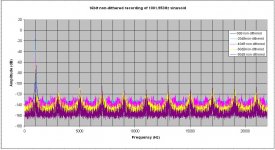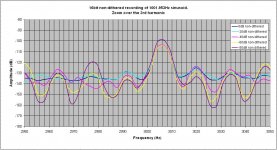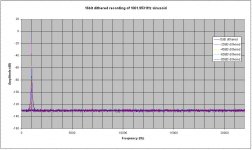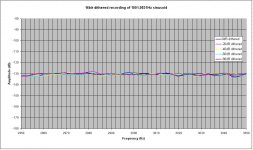BTW I hope Richard realizes eventually that the total THD + noise is always > the single highest peak spurious tone. His current definition of DNR is far more lenient than (dare I say) the standard one.
Yes, I agree.... eventually and in more realistic signal conditions than the Standard. I was setting up the dynamic range and then where listening is heard with respect to the bits.
THx-RNMarsh
Yes, I agree.... eventually and in more realistic signal conditions than the Standard. I was setting up the dynamic range and then where listening is heard with respect to the bits.
THx-RNMarsh
I respect your quest for what you want out of HD just like to keep things technically on the up and up.
There are so many variables I can't find a single comparison without potential flaws and the problem is often that they don't understand the underlying technology in detail.
I certainly agree with you..... and some of it is brought up and IMO amounts to noise which I dither in my head to keep focused on the main thrust;
If the bits were 24 the mid range listening level would be centered around 12 bits instead of 8 and IMHO this is why I hear an improvement that is quit a bit better.
And if 32... centered around 16 bits and THAT would be Perfect.... as remote as that is. But I'll take 24 now and enjoy it immensely.
Your thoroughness, is greatly appreciated. Especially where it adds directly to the point.
OK. I'm done on this one. What's next?
John?
THx-RNMarsh
If the bits were 24 the mid range listening level would be centered around 12 bits instead of 8 and IMHO this is why I hear an improvement that is quit a bit better.
And if 32... centered around 16 bits and THAT would be Perfect.... as remote as that is. But I'll take 24 now and enjoy it immensely.
Your thoroughness, is greatly appreciated. Especially where it adds directly to the point.
OK. I'm done on this one. What's next?
John?
THx-RNMarsh
Last edited:
So if I am taking this correctly the final conclusion would be to not attenuate with the CD players volume control but to do that in the analog section. Now I know someone may say that you would then have some increase in some form of noise but you would not lose dynamic range in the same manner. Now the question is are CDP lowering the level on the digital side or is that variable output done on the analog side after conversion in the dac?
Last night, Bob Cordell, and several others who check in here, and I met at an linear designers party. Bob and I have had our differences over the years, especially on DIY. However, here was a 'professional' atmosphere, and we behaved like professional people. I even admitted how I had learned some important things from his input, over the years. There was no playing 'Gotcha', like SE likes to play here, that isn't acceptable discourse, and it should not be that here. There are medications available from a doctor that can help keep the tone here civil. I use them, myeslf! '-)
A yoghurt a day keeps troubles away, eh?
I want to say something 'professional' about Richard Marsh: I have known him for about 35 years, and first learned from him, the importance of dielectric distortion in capacitors relative to audio applications. I had IGNORED it, previously. This led to all servoed gain modules that I use today, in order to remove the coupling caps. I have no qualms about removing potentially troublesome caps. Richard also was the first person to clue me in to using extensive ground planes for audio. I thank him for that. Richard Marsh has designed a number of audio products, and he even had his own company at one time. This includes: amps, preamps, powerline filters, and who knows what else? He got a patent on a 'revolutionary' high quality film cap that is still made today. I never used it, but it is PERFECT for switching power supplies and such, and potentially valuable for linear applications as well. This is someone who has paid his dues, and he deserves, like everyone else to be addressed in a courteous manner.
I want to say something 'professional' about Richard Marsh: I have known him for about 35 years, and first learned from him, the importance of dielectric distortion in capacitors relative to audio applications. I had IGNORED it, previously. This led to all servoed gain modules that I use today, in order to remove the coupling caps. I have no qualms about removing potentially troublesome caps. Richard also was the first person to clue me in to using extensive ground planes for audio. I thank him for that. Richard Marsh has designed a number of audio products, and he even had his own company at one time. This includes: amps, preamps, powerline filters, and who knows what else? He got a patent on a 'revolutionary' high quality film cap that is still made today. I never used it, but it is PERFECT for switching power supplies and such, and potentially valuable for linear applications as well. This is someone who has paid his dues, and he deserves, like everyone else to be addressed in a courteous manner.
Disingenuousness is not, regardless of one's past accomplishments, deserving of such courtesy. Such courtesy is earned by not being disingenuous.
se
I agree with Dave (Max) and Richard Marsh that we never use the total bits allowed, except on an occasional peak. So, most CD is recorded like 8-12bits, not 16bits. Now what does this mean? Well, dither WILL cover up harmonic distortion as defined mathematically from a series of 'snapshots' that could be taken from an 8 bit digitized sine wave. Now, EVERY 'snapshot' will have a certain amount of NONLINEARITY, or departure from the original audio signal, that is for sure. How to know if this 'nonlinearity' is still audible after dithering, depends on how the human ear responds to it. For me, the nonlinearity is still there, even if my test equipment can't directly measure it.
This is sort of how my pea brain works -- conceptually most of the time. So I drew a diagram. BTW, only one person got it quit awhile ago;
View attachment 467677
In the area of the dynamic range being played and listened to..... you have much fewer bits and higher distortion...... easily in the 0.1 to 1% for the bulk of the mid level music as was mentioned by another.
Richard
I love seeing seniors retaining the sparkling imagination of the youth, but the distortion escalation implied by the right hand vertical axis marking (50% THD half way btn 0% and 100%) of the linked pdf, is way beyond provable reality, eeven if quoted THD is actually THD+N.
In particular, for a pure sine wave output at say -20dB FS, for a 16 bit PB system what are the consequent differences WRT 0dB FS output.
Dan, please see the four attachments
Generated files: 1001.953Hz sinusoid Mono (0dB, -20dB, -40dB, -60dB, -80dB), 5 seconds duration each, format 32bit, 44.1kHz
Saved as 16bit, 44.1kHz wav first without dithering, then with dithering (Steinberg Wavelab dither: Type Internal 1, No noise shaping)
Then each file was imported to Audacity for FFT (16384 points), then export in .txt, then .txt imported to Excel for data plotting.
George
Attachments
Rather close to home for many here. The over use of any adjective renders it useless as Penn so aptly showed it this video . Those who some how heartily embrace dogma are not easily persuaded by facts. Much like those with irreverent and irrelevant fact discount controlled observation as not agreeing with their view and thus flawed."Which of these feels better to eat"Many folks preference for organic has nothing to do with taste.
Dan, I've been going in the other direction. It's extremely rare now that I hear vinyl that's good enough for me to pay attention, and I am surprised that this is so - I'm somewhat curious as to what's going on, decades ago I heard some excellent LP playback. Demos at audio shows, shops are nearly universally blaaahh - possibly because the enthusiasm for getting the most out of this medium has diminished.A few months back I repaired a vinyl system for a friend and played a mint Helen Reddy vinyl that I had on hand, and also digital copy that I am well familiar with.
I had run up the system on a selection of usb digital and CD before he came to collect and all sounded good.
When he arrived I played the HR vinyl and I was floored compared to the digital version.
So much more presence/articulation/clarity that I had not heard in a long time due to my digital only PB for yonks.
The only approach should be that is that all the circuitry is running with zero attenuation of the signal, except that at one and one only point the volume is controlled: this could be a digital, or extremely well done analogue mechanism - anything else could cause audible problems.So if I am taking this correctly the final conclusion would be to not attenuate with the CD players volume control but to do that in the analog section. Now I know someone may say that you would then have some increase in some form of noise but you would not lose dynamic range in the same manner. Now the question is are CDP lowering the level on the digital side or is that variable output done on the analog side after conversion in the dac?
This is something that's always been of primary importance, to me ...
It seems we're on an endless treadmill with this digital "not being good enough",I agree with Dave (Max) and Richard Marsh that we never use the total bits allowed, except on an occasional peak. So, most CD is recorded like 8-12bits, not 16bits. Now what does this mean? Well, dither WILL cover up harmonic distortion as defined mathematically from a series of 'snapshots' that could be taken from an 8 bit digitized sine wave. Now, EVERY 'snapshot' will have a certain amount of NONLINEARITY, or departure from the original audio signal, that is for sure. How to know if this 'nonlinearity' is still audible after dithering, depends on how the human ear responds to it. For me, the nonlinearity is still there, even if my test equipment can't directly measure it.
And people say this because it doesn't "sound good enough" - in the flesh! But this is all about insufficient attention to detail in optimising the playback, nothing to do with the format!! If the playback is right, then there is nothing audibly wrong with the sound !!
Now, EVERY 'snapshot' will have a certain amount of NONLINEARITY, or departure from the original audio signal, that is for sure. How to know if this 'nonlinearity' is still audible after dithering, depends on how the human ear responds to it. For me, the nonlinearity is still there, even if my test equipment can't directly measure it.
No THIS IS WRONG, I don't know why we even bother.
Can I pay tribute to the scientific rigor of your comments, Scott ?I respect your quest for what you want out of HD just like to keep things technically on the up and up.
Certainly, but I invite any valid criticism since we might both learn something new.Can I pay tribute to the scientific rigor of your comments, Scott ?
- Status
- Not open for further replies.
- Home
- Member Areas
- The Lounge
- John Curl's Blowtorch preamplifier part II




